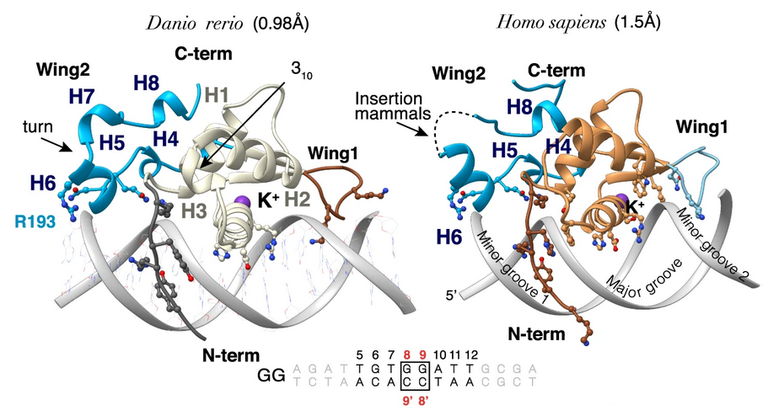Do you want to keep up to date? Subscribe to our newsletter. 1 mail every 2 months! |
 |

Figure: Detailed structure of the FoxH1 protein with different resolutions. The samples come from zebrafish, scientific name 'danio rerio' (left), and from humans (right).
Cerdanyola del Vallès (Barcelona), 25th of January 2023. Transcription factors are proteins that interact with DNA to regulate the function of some genes. In general, a single transcription factor binds to various parts of the genome given the complexity of the processes in which they participate, in which they inhibit or activate several genes simultaneously. Specifically, FoxH1 is a key transcription factor in the process of developing embryos and in the evolution of some types of leukemia and pulmonary cancer.
A research group from IRB Barcelona (Biomedic Research Institute of Barcelona) lead by the ICREA researcher Dra. Maria J. Macias, has succeeded in detailing the process of binding of this protein to DNA at unprecedented scales, of the order of the atom, around one angstrom (1Å).
The structural details revealed in this work can allow the development of specific molecules that interact with FoxH1 and, potentially, give rise to drugs to treat diseases in the future in which this protein plays an essential role.
The structural data were obtained at the XALOC beamline, devoted to macromolecular crystallography. Using the X-ray diffraction technique, XALOC allows to obtain a high-resolution three-dimensional image of the molecular structure.
Reference: Radoslaw Pluta, Eric Aragón, Nicholas A. Prescott, Lidia Ruiz, Rebeca A. Mees, Blazej Baginski, Julia R. Flood, Pau Martin-Malpartida, Joan Massagué, Yael David & Maria J. Macias Nature Communications (2022) DOI: 10.1038/s41467-022-34925-y
Link to the original news: https://www.irbbarcelona.org/en/news/scientific/researchers-uncover-mechanism-action-important-transcription-factor




